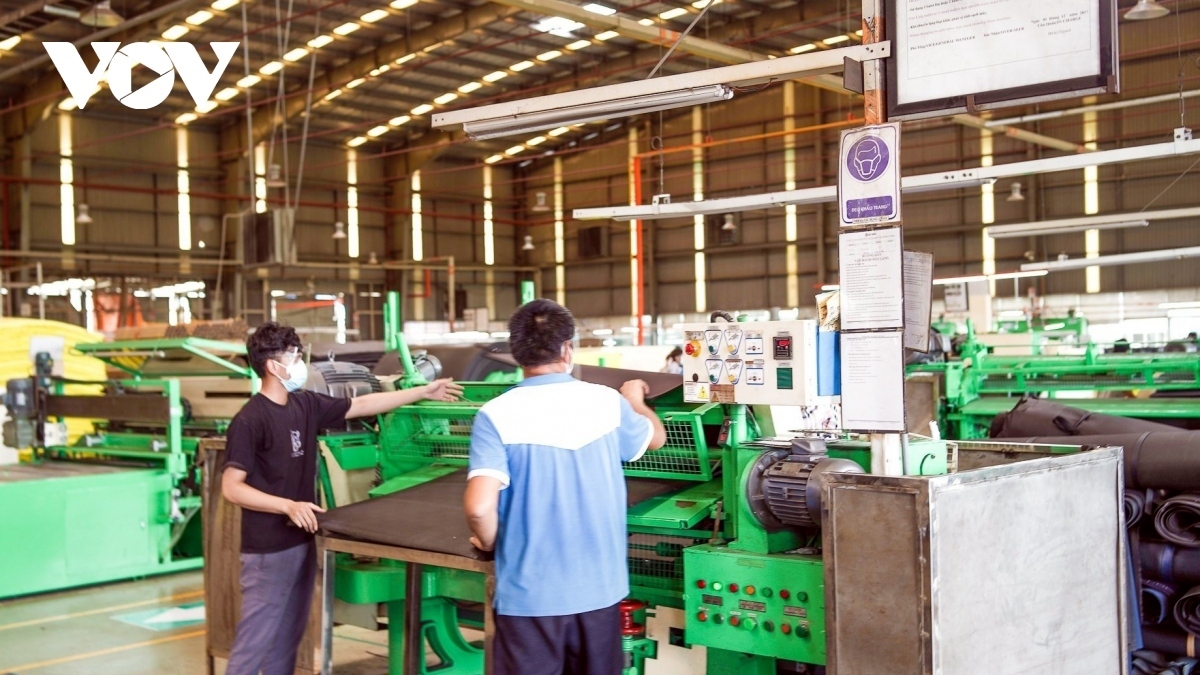Target set to raise proportion of manufacturing technology in GDP to 30% by 2030
VOV.VN - The Ministry of Industry and Trade has set a target of an average industrial value-added growth rate of over 8.5% per year, with the proportion of the manufacturing industry as part of GDP reaching about 30% by 2030.
In order to effectively implement the Politburo’s Resolution No 29 regarding continuing to accelerate the national industrialisation and modernisation process until 2030 with a vision towards 2045, the project on restructuring the industry and trade sector in the period up to 2030 has just been submitted to the Government by the Ministry of Industry and Trade. In line with this, the Ministry of Industry and Trade has set a target in this period that the industrial value-added growth rate will reach an average of over 8.5% annually.
It is anticipated that the proportion of the value of high-tech industrial products in the processing and manufacturing industries will reach over 45%, whilst the export proportion of processed and manufactured goods will rise to about 90%.
According to the assessment made by the Ministry of Industry and Trade, the national industrialisation process in recent years still has endured some limitations, particularly as industrial development has not met the requirements of industrialisation and modernisation, whilst low added value that has not been deeply involved in regional and global value chains.
The internal strength of the industry and the economy therefore remains weak, with independent capacity and low self-control that still depends heavily on the foreign-invested sector.
Furthermore, the capacity of industrial enterprises, especially with regard to the level of science and technology, remains limited. In line with this, platform industries and industries prioritised for development have so far failed to meet the set targets.
Deputy Minister of Industry and Trade Do Thang Hai has therefore frankly acknowledged the current situation with regard to Vietnamese industry, with these limitations being one of the fundamental causes of slowing down the process of industrialisation, failing to realise the goal of turning the nation into a modern industrialized country by 2020.
Economic expert Phan Duc Hieu, a standing member of the National Assembly NA)'s Economic Committee, acknowledged that it is necessary to solve any existing shortcomings and weaknesses.
Nguyen Chi Sang, vice chairman of the Vietnam Association of Mechanical Enterprises, also said that Vietnamese industry depends a lot on imports, while many are able to completely manufacture for themselves, thus improving the localisation rate.
Although imports and exports reached over US$700 billion last year, 75% of them belonged to foreign direct investment (FDI), figures which ultimately mean foreign dependence.
As a means of overcoming these shortcomings and limitations, in order to achieve the criteria of becoming an industrial country through the project on restructuring the industry and trade sector ahead of 2030, the Ministry of Industry and Trade has proposed many solutions. There is a particular focus on fine-tuning the legal system, as well as developing criteria to restructure the list of fundamental and prioritised industries for the 2030 and 2045 period.
Appreciating the solutions proposed by the industry and trade sector, including promoting the development of supporting industries in order to serve major export industries such as electronics, automobiles, garments and textiles, footwear, mechanics, and high technology, economist, Dr. Le Dang Doanh underlined the need to utilise the nation’s advantages for sustainable industrial development.
Specifically, the industrialization process should combine agriculture and industry, whilst also building fields for processing agricultural products in a bid to increase the value of Vietnamese agricultural products.
Agreeing with this point of view, Le Thuy Trung, deputy head of the Department of Industrial Economics and Services under the Ministry of Planning and Investment, emphasized the role of localisation in industries and the role of connecting Vietnamese enterprises with FDI ones in the supply chain.
Most notably, the Ministry of Industry and Trade's project on restructuring the Industry and trade sector for the period towards 2030 also specifically stated the focus on fully developing the domestic industrial production system through upgrading and developing the supply and value chain of industries.
It can be viewed as necessary to focus on localising the supply chain of industries to reduce dependence on imported machinery, equipment, and raw materials, as well as striving to enhance autonomy, improve domestic added value, and the overall competitiveness of products and the position of Vietnamese enterprises in the global value chain.

